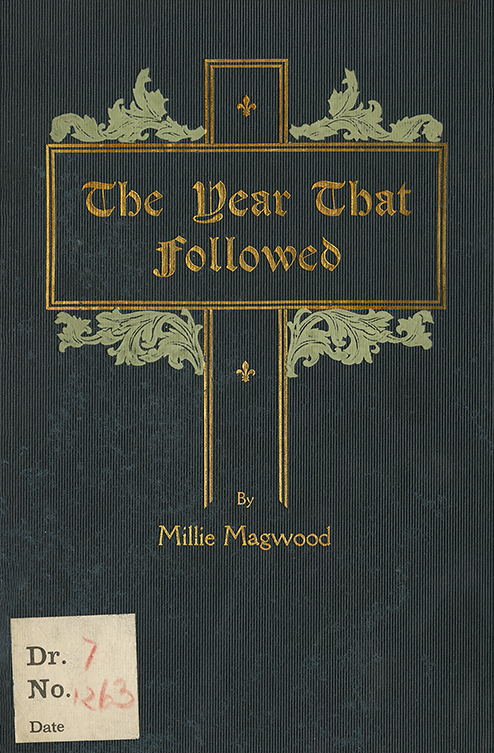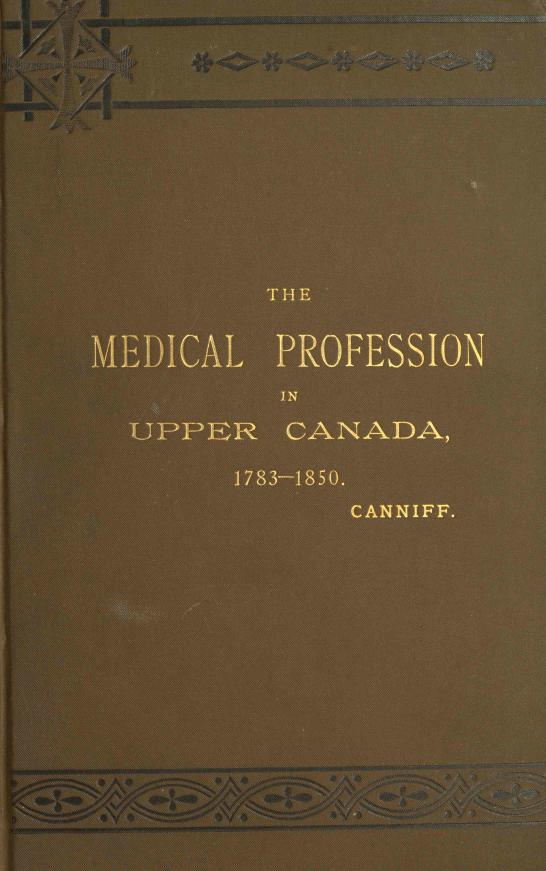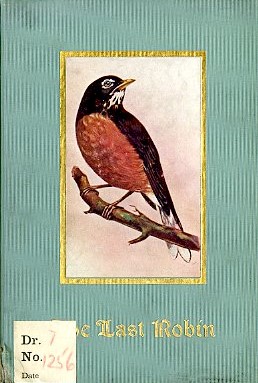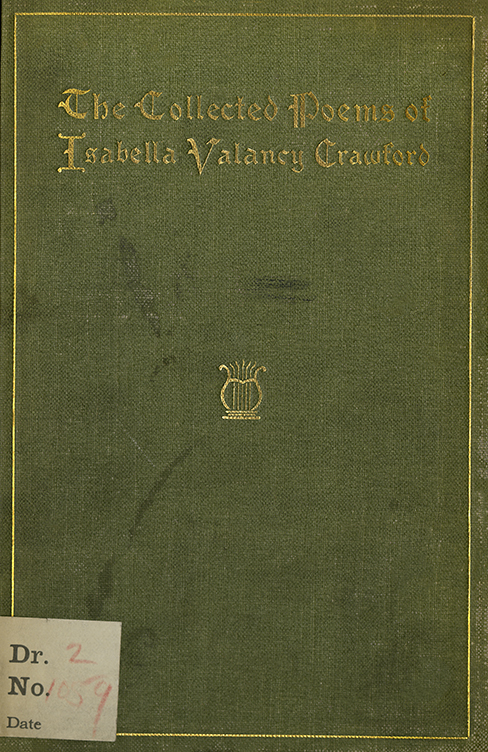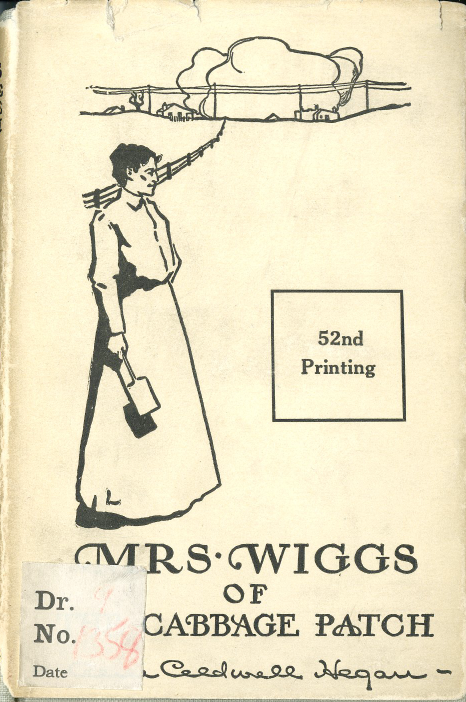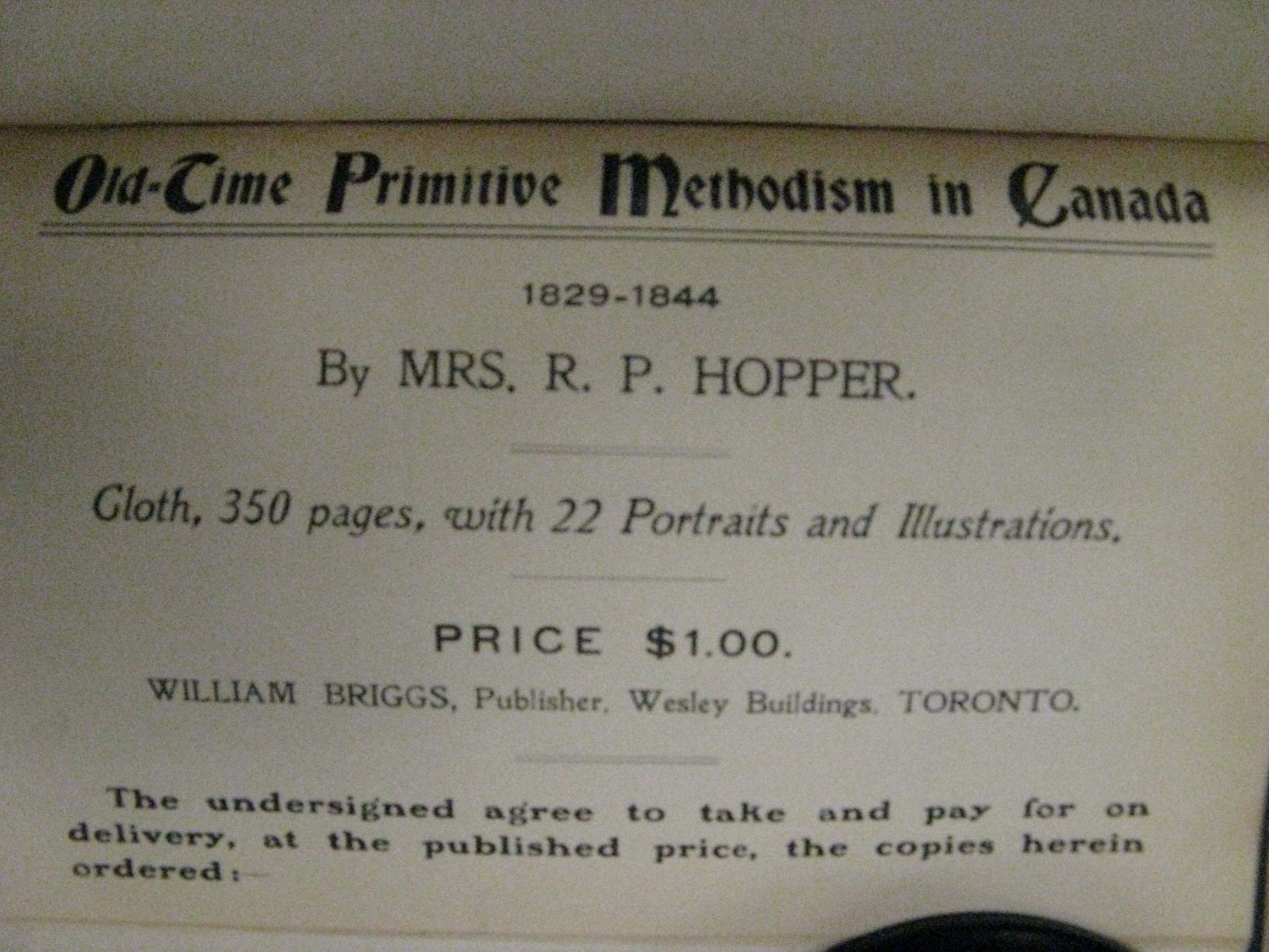
DURING the ninety years that preceded the adoption in 1919 of “The Ryerson Press” as its trade-book imprint, books and pamphlets issued by the Methodists’ Toronto printing, publishing, and bookselling establishment frequently appeared under the imprint of the book steward of the day. This practice accounts for the appearance of works under the imprints of: Egerton Ryerson, James Richardson, Matthew Lang, John Ryerson, Alexander McNab, Anson Green, George R. Sanderson, Samuel Rose, and William Briggs.1 Overtly denominational works like hymn books, however, were typically issued under the imprint of the organization — for example, through the middle decades of the nineteenth century, the “Wesleyan Book Room” (or variations thereof) served as a church imprint; after 1874, the “Methodist Book and Publishing House” (MBPH). That said, even a brief scan of nineteenth-century titles listed in W. Stewart Wallace’s The Ryerson Imprint makes it very clear that consistency around the imprint was not a pressing concern. For instance, in 1857, William Arthur’s The Tongue of Fire; or, The True Power of Christianity appeared under an imprint that combined the name of the book steward with that of the organization, stating: “Published by G.R. Sanderson, Wesleyan Book Room.” However, Archibald MacCallum’s Synopsis of Natural History, published that same year, appeared under the imprint: “John Donogh, Guardian Steam Printing Establishment.” Donogh was the printer who worked under Sanderson, so this particular imprint would suggest that MacCallum’s work was a straightforward printing job.
Prior to 1919, the financial arrangements that underpinned the issue of books and pamphlets varied. Anybody looking into the publishing history of a particular title must keep that in mind, and will likely need to probe beyond the imprint to establish the nature of the financial arrangement that prevailed. The simplest arrangement was a printing agreement in which the author of the work provided the manuscript, paid for all production costs from typesetting through printing, received the resultant stock, and then sold or distributed copies of the work independently. This option endured throughout the nineteenth century and into the twentieth. However, over the course of the nineteenth century, MBPH came to offer variations on the straightforward printing arrangement.

In the nineteenth and early twentieth centuries, not all authors had the wherewithal to cover the costs of production using their own funds. Publishing by subscription provided one way to counter that difficulty. In these cases, an author would first have a prospectus (description) of the book printed, including the projected price of the volume, and then subscribers would be secured. Once a sufficient number of subscribers had been acquired as a guarantee against the costs of production, the manufacture of the book could go forward; insufficient subscribers could bring the whole venture to a standstill. Since subscribers were not always reliable, they might well be asked to provide a portion of the cost in advance, with the remainder on delivery.2 As late as 1907, archival records of the MBPH show that Millie Magwood agreed “to secure orders to cover [the] cost” of issuing her novel The Year that Followed.3
In its original iteration, subscription publishing relied heavily on the initiative of authors and their personal circles to secure subscribers, an effort which might well include publishing the prospectus in newspapers. In the latter decades of the century, a second form of subscription publishing emerged among publishers in North America when the industry identified publishing-by-subscription as a potential mechanism to market more expensive books directly to the public and fulfill orders via the post, a strategy which allowed them to achieve greater profits by bypassing discounts to retail booksellers. By 1882, MBPH had a subscription book department in place, which was managed by J.C. Berkinshaw. This more sophisticated version of subscription publishing typically involved the hiring of “agents,” who went door-to-door in their efforts to secure subscribers; such agents might carry not only a prospectus of the work, but also samples of the binding, type, and illustrations of the projected volume.4

Surviving correspondence between William Canniff and Berkinshaw reveals that Canniff’s The Medical Profession in Upper Canada, 1783-1850 (1894) was issued through MBPH’s subscription book department. Even so, Canniff played quite a prominent role in decisions about the title, suggesting his arrangement with the firm might have been something of a hybrid between the two versions of subscription publishing. Prior to publication, for example, the author confirmed a certain number of subscribers of his own initiative; after publication, difficulties with securing payment from these subscribers, or delivering the work to them, were referred back to Canniff. As payments for the work came in, they were credited against Canniff’s account, something else which suggests the earlier form of subscription publishing. On the other hand, Berkinshaw’s letters to Canniff indicate that he, Berkinshaw, hired agents who also canvassed for subscribers, and ensured that review copies went out to newspapers and journals in Ontario.5
By the latter decades of the nineteenth century, the commission arrangement became an extremely common method used by MBPH in its contracts with authors. This form of book publishing continued well into the twentieth century. In a commission arrangement, the author still covered all production costs. Under such contracts, however, the firm agreed to market the work for a commission. That is, the firm engaged in advertising the work, and had its salesmen (known as travellers) seek orders for it during their regular sales rounds. Surviving correspondence authored by Edward S. Caswell, manager of MBPH’s book publishing department from the early 1890s to 1909, also indicates that authors could benefit from editorial advice on their manuscripts as part of a commission arrangement. Once a title was published, MBPH would take a commission on any sales of the volume based on its retail price. That commission typically ran between 40 and 50 per cent since the commission rate factored in the wholesale discount to booksellers, which at the time ran around 33 per cent. The difference between the commission rate and the retailer’s discount was how the firm received compensation for its marketing services.

Surviving archival evidence indicates that numerous titles issued under the Briggs imprint appeared through a commission arrangement. Several examples found in the McGraw-Hill Ryerson Press Collection include: C.F.P. Conybeare’s Lyrics from the West (1907); Ethelwyn Wetherald’s The Last Robin: Lyrics and Sonnets (1907); and Charles Clarke’s memoir, Sixty Years in Upper Canada (1908).6 A typical print run for a book produced under a commission arrangement was 500 or 1000 copies. On rare occasions, a book that began under a commission arrangement might be switched to a royalty arrangement. For example, when poet Robert W. Service first contacted MBPH about his Songs of a Sourdough (1907), he included a cheque to cover production costs since his original plan was to produce a “Christmas keepsake” for friends and relatives at his own expense; once the manuscript was received, Caswell and another MBPH employee, John McClelland, the head of the library department, saw commercial potential in it and worked together to convince Briggs to take on the book on a royalty basis.7 The work became a longtime bestseller.
Royalty arrangements — the form of financial arrangement between author and publisher with which readers will be most familiar — played only a modest role in MBPH’s contracts with Canadian authors prior to 1919. In Canada, the risks inherent in publishing books for the small Canadian market in the nineteenth and early-twentieth centuries did not encourage royalty arrangements. (In 1901, Canada’s population was just over 5 million.) A small market results in shorter print runs, which leads to a book with a higher unit cost. In a straightforward royalty arrangement, the publisher takes on all the costs of production, and the author is offered a royalty on each copy of the work sold. The royalty could potentially be calculated on the basis of the wholesale or retail price of the volume. Graduated royalties could also feature in the royalty contracts of publishers during this period — that is, the royalty rate received by the author would go up after a certain number of copies were sold. (For example, a higher royalty after the first 10,000 copies, a very high bench mark for the period!)

Evidence of royalty arrangements can be found in the archival records of MBPH as early as the 1880s,8 but were fairly rare throughout the nineteenth century. A direct royalty arrangement with a Canadian author from the 1890s onward would typically see MBPH covering all costs of production, with the author offered a 10% royalty on the retail price of the title. Such was the case for volumes of verse like The Poems of Wilfred Campbell (1905) and Jean Blewett’s The Cornflower and Other Poems (1906) , as well as J.P. Buschlen’s prose work Behind the Wicket (1914). For certain royalty contracts, however, the firm hedged its bets by seeking some type of guarantee. In the case of Catharine Parr Traill’s Pearls and Pebbles (1894), the author was required to secure 200 subscribers in advance of publication to offset the risks of publication.9 For John W. Garvin, who entered into a royalty agreement when he published the edited edition The Collected Poems of Isabella Valancy Crawford (1905), the requirement was a guarantee of $400 against the cost of issuing the title; the firm agreed he could pay back this money over time, in part through crediting his royalties against the amount of the guarantee as copies were sold.10
In addition to contracting directly with Canadian authors, from the latter decades of the nineteenth century, MBPH also published books as a result of contracts with the Ontario government, as well as other publishers, both domestic and foreign. Two government contracts related to the textbooks Public School Physiology and Temperance (1893) by William Nattress and the Ontario High School German Reader (1911), edited by A.E. Lang. In 1898, the firm entered into an agreement with fellow Toronto publisher Copp, Clark to co-produce an elementary history of Canada authored by Emily Weaver: Canadian History for Boys and Girls (1900; 1905). The two publishers agreed to share production costs and profits equally, and the work appeared with the imprint of both firms; the author was given a 10% royalty on the retail cost of each copy sold.11 In 1901, MBPH entered into a printing and distribution contract with Toronto’s Westminster Company for bestselling novelist Ralph Connor’s The Man from Glengarry (1901). MBPH was provided with a set of plates from which to produce the work, and the book appeared solely under Westminster’s imprint. However, the contract had MBPH commit to paying a 30% royalty on the retail price of each copy sold from a 5000-copy print run, with the royalty on the first 2500 copies paid up front on date of publication.12

When it came to foreign publishers, in some cases MBPH negotiated for an edition of a specific title for the Canadian market. For instance, a Canadian edition of Alice Caldwell Hegan’s Mrs. Wiggs of the Cabbage Patch appeared under the Briggs imprint as early as 1902. In other cases, the firm made arrangements to serve as Canadian “agent” for all of a foreign publisher’s works, or a subset of them, like a series. For example, in 1904 MBPH contracted to serve as Canadian agent for the bibles, prayer books, and hymn books produced by Eyre and Spottiswoode Bible Warehouse (London, UK) and Thomas Nelson and Sons (New York).13 Finally, although it was a more challenging prospect to achieve, MBPH managers like Samuel B. Gundy also sought out co-publishing arrangements with foreign publishers for original Canadian titles. One successful effort in this regard was A Treasury of Canadian Verse. Edited by Theodore H. Rand, in 1900 it appeared under the dual imprint: “Toronto: William Briggs / London: J.M. Dent.”

By 1919, the topical nature of the books and pamphlets that had issued from MBPH and its predecessors ran the gamut, including: religious works; textbooks; memoirs, autobiography, and biography; travel narratives; self-help books; poetry; short story collections and novels. Fiction only really gained ground after 1875, when long-standing moral resistance to it within the Methodist community began to give way. The initial ambivalence toward fiction can be found in the introductions of some of the earlier works that fall in this category. When Methodist minister David Hickey published William and Mary: A Tale of the Siege of Louisburg, 1745 (1884), he noted in his preface that while he was not sure the work could claim the “distinction” of being a religious novel, he firmly believed it was “strictly moral.”14 Four years later, Joseph Hilts included an introduction in his Among the Forest Trees; or, How the Bushman Family Got Their Homes that detailed how his work constituted fact draped in fiction. “The book is really a narrative of facts and incidents,” he explained, “around which the imagination has been permitted to throw some of the draperies of fiction.” In keeping with Hickey’s position, Hilts added: “All the drapery and coloring must be in strict harmony with pure morality, and with the demands of a sound religious sentiment.”15 Those curious about fiction’s movement toward respectability in Canadian cultural life might well explore it through the prefaces and introductions of fictional works issued by MBPH prior to 1919.
1 The period of service as Book Steward for each of these men can be found in Lorne Pierce, ed., The Chronicle of a Century (Toronto: Ryerson Press, 1929) x.
2 More about subscription publishing can be found in Mary Lu MacDonald, “Subscription Publishing,” in History of the Book in Canada. Volume One: Beginnings to 1840, ed. Patricia Lockhart Fleming, Gilles Gallichan, and Yvan Lamonde (Toronto: U of Toronto P, 2004) 78-80.
3 Entry for Miss Millie Magwood, Ledger, costs of publication and sale of selected works,1908-1913, box 3, Board of Publication Papers, United Church of Canada Archives.
4 Janet B. Friskney, “Beyond the Shadow of William Briggs, Part II: Canadian-authored Titles and the Commitment to Canadian Writing,” Papers of the Bibliographical Society of Canada 35.2 (Fall 1997): 165-66.
5 Friskney 173-75.
6 Entries for C.F.P. Conybeare’s Lyrics from the West and Ethelwyn Wetherald’s The Last Robin: Lyrics and Sonnets, Ledger, costs of publication and sale of selected works, 1908-1913, box 3, Board of Publication Papers, United Church of Canada Archives. For Charles Clarke’s Sixty Years in Upper Canada, see agreement #30, box 6, Board of Publication Papers.
7 Peter J. Mitham, Robert W. Service: A Bibliography (New Castle, Delaware: Oak Knoll Press, 2000) 3-4.
8 See “Notebook of Costs of Various Printed Materials, 1881-1890,” box 3, Board of Publication Papers.
9 Friskney 175.
10 Agreement #84, box 7, Board of Publication Papers.
11 Agreement #256, box 9, Board of Publication Papers.
12 Agreement #39, box 6, Board of Publication Papers.
13 Agreement #75, box 7, Board of Publication Papers.
14 David Hickey, William and Mary: A Tale of the Siege of Louisburg, 1745 (Toronto: William Briggs; Montreal: C.W. Coates; Halifax: S.F. Huestis, 1884) iii.
15 Joseph H. Hilts, Among the Forest Trees, or, How the Bushman Family Got Their Homes: Being a Book of Facts and Incidents of Pioneer Life in Upper Canada, Arranged in the Form of a Story (Toronto: Printed for the author by William Briggs, 1888) v-vi.






